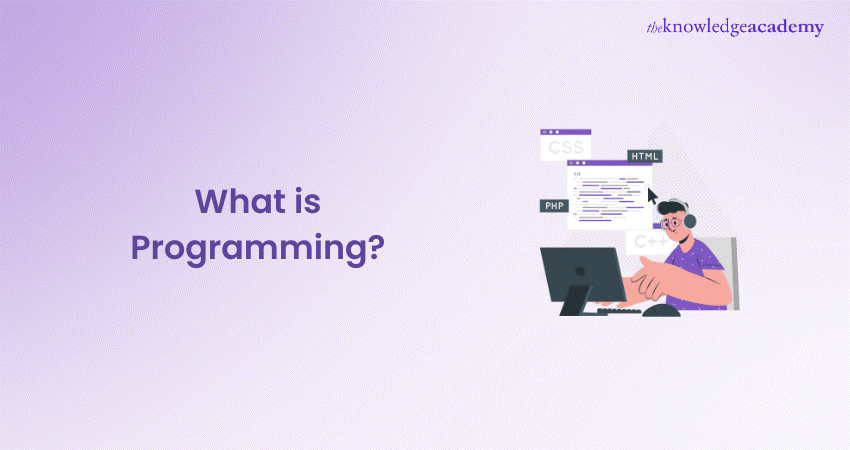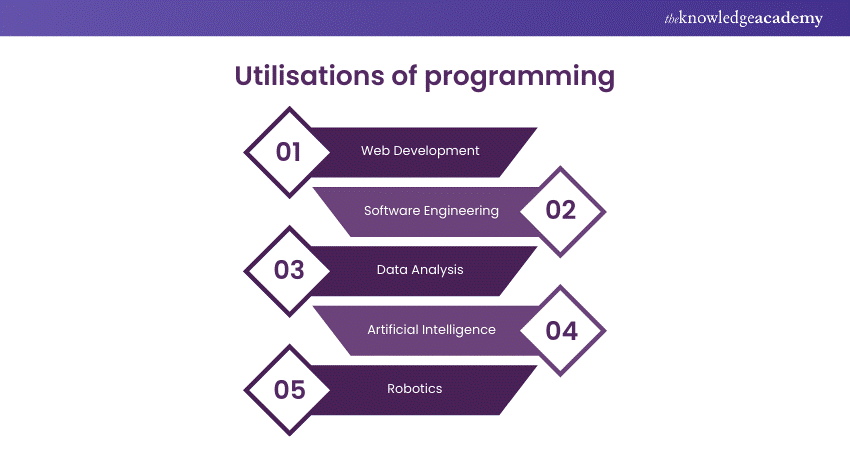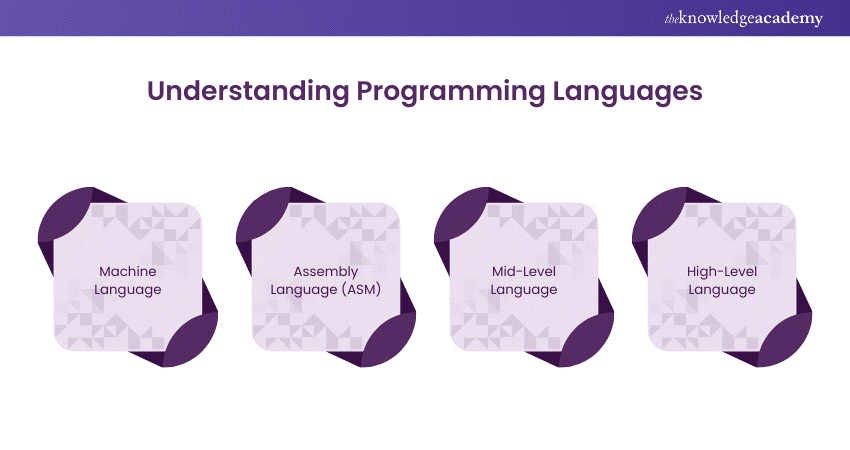We may not have the course you’re looking for. If you enquire or give us a call on +61 272026926 and speak to our training experts, we may still be able to help with your training requirements.
We ensure quality, budget-alignment, and timely delivery by our expert instructors.

Programming is the composition of sequences of instructions. These sequences are called programs. Computers follow these patterns to perform tasks. It includes designing and implementing algorithms. If further condensed, the process can be described as teaching a computer how to think or act. This blog provides an easy-to-understand introduction to What is Programming. Read through to learn more!
Table of Contents
1) What is Programming?
2) How does Programming function?
3) Utilisations of Programming
4) Significance of Programming for organisations
5) Understanding Programming languages
6) The diversity of Programming languages
7) Logical structures within Programming
8) Tools and technologies in Programming
9) Getting started in computer Programming
10) Difference between coding and Programming
11) Conclusion
What is Programming?
Programming is teaching the computer what to do. More specifically, it refers to a procedure of writing codes in several Programming languages, such as Python, Java, and C++, among others, to create software applications, systems, and tools. It is a creative process—from the conception of an idea to a feasible working system.
Why Programming is needed?
Programming is essential because it powers the technology we use every day — from smartphones to cars to the internet. Without Programming, we wouldn’t have:
1) Websites
2) Mobile applications
3) Video games
4) Online banking
5) Automated manufacturing
It also enables us to solve complex problems and automate repetitive tasks, enhancing efficiency and enabling innovation and technological advancements.
How does Programming function?
Programming works by following these general steps:
1) Problem identification: Recognising and defining the problem or the task to be completed.
2) Planning: Outlining a solution, usually through algorithms or pseudocode.
3) Coding: Writing code in a Programming language.
4) Testing: Running the program to find and fix bugs or errors.
5) Deployment and maintenance: Implement the program in a live environment and update it as needed.
Through these steps, Programming translates logical solutions into a language that computers can understand.
Utilisations of Programming
Programming has a myriad of applications across different fields and industries. Here are some key utilisations:

1) Web Development: Creating and maintaining websites.
2) Software Engineering: Designing and developing software.
3) Data Analysis: Processing and analysing large data sets to find patterns or make predictions.
4) Artificial Intelligence: Building systems that can mimic human intelligence and perform tasks such as recognising speech images or making decisions.
5) Robotics: Developing algorithms that control the behaviour of robots.
Significance of Programming for organisations
For businesses, Programming is invaluable. It helps in:
1) Automation of operations: Streamlining business processes through software, reducing cost and increasing efficiency.
2) Data management: Efficient handling, storage, and analysis of data to enhance decision-making.
3) Customer engagement: Programming enables better customer service and interaction through apps and websites.
4) Innovation: Staying competitive by adopting the latest technologies and trends like IoT, blockchain, and more.
Understanding Programming Languages
Programming languages are essential tools that enable developers to communicate instructions to a computer efficiently, with the Go Programming Language being a popular choice for its simplicity and performance. They are categorised based on their level of abstraction and the control they offer over hardware.

1) Machine Language (ML)
Machine Language is the lowest level of Programming language. It is made up of 0s and 1s; binary code, hence running directly through the Central Processing Unit (CPU) of a computer. In a sense, machine language Programming is thus very hardware-specific because every type of CPU has its own machine language.
2) Assembly Language (ASM)
Assembly language is a level above Machine Language and contains mnemonics that are symbolic representations of various machine code instructions; these instructions are far easier for humans to understand and write. Each statement in a program written in assembly language corresponds exactly to one in machine language. An assembler is a program that converts an assembly code program into executable machine code.
3) Mid-level language
Mid-level languages serve as a bridge between the low-level control of assembly languages and the high-level abstraction of advanced Programming languages. C is the most prominent example of a mid-level language, offering both the high-level functionalities necessary for developing complex programs and low-level features that allow detailed manipulation of hardware.
4) High-level language
High-level languages abstract the details of the computer hardware from the process of Programming, therefore allowing the developer to focus more on the logic of the application and less on the mechanics of the hardware. For instance, Python, Java, and C++. They are easy to use, flexible, and easily applied in all kinds of Programming, from software engineering to web development.
The diversity of Programming languages
The diversity in Programming languages allows developers to choose the most appropriate language based on the specific needs of their project, considering factors like application type, system resources, and performance requirements. From specialised languages designed for statistical analysis, such as R, to languages geared towards systems Programming, like Rust, the variety ensures that there is a tool for every job.
Unlock the power of OOP and elevate your coding skills with our comprehensive Object-Oriented Programming Course – Join now and transform your Programming prowess!
Logical structures within Programming
Logical structures are the fundamental elements of Programming that enable the control of flow within programs. These include:
1) Sequences: The default mode of operation where instructions are executed in order, one after another.
2) Decisions: Structures that involve choosing between different paths based on conditions, typically implemented using if-else or switch-case statements.
3) Loops: Used to iterate a block of code multiple times until a particular condition changes, common constructs include for, while, and do-while loops.
Understanding these structures is crucial for Programming because they enable developers to dictate not just what a computer should do but how it should handle different situations dynamically.
Tools and technologies in Programming
The field of Programming is diverse, with various tools and technologies that cater to different Programming needs. Understanding these tools is a step towards mastering Programming:
1) Programming languages: These are the core tools for any programmer. Popular languages include Python, Java, JavaScript, C#, and Ruby. Each language has specific uses, such as web development, software engineering, data analysis, and more.
2) Integrated Development Environments (IDEs): IDEs like Visual Studio, Eclipse, and PyCharm provide programmers with tools to write, test, and fix their code in a single application.
3) Version Control Systems (VCS): Tools like Git help manage changes to source code, facilitating collaboration among Programming teams.
4) Databases: Knowledge of databases is crucial. SQL databases like MySQL and PostgreSQL and NoSQL databases like MongoDB are widely used. The Difference between MongoDB and MySQL lies in their structure, with MongoDB being schema-less and MySQL using structured tables.
5) Frameworks and libraries: These are sets of pre-written code that programmers can apply to solve common problems or perform common tasks in a more standardised way. For example, React is used for front-end development, and Django is used for Python-based web applications.
Elevate your coding game with our D Programming Language Training – master a modern, efficient language and unleash your Software Development potential today!
Getting started in computer Programming
Beginning your journey in computer Programming involves a structured approach. Here’s how you can start:
1) Define your Programming objectives
Understanding what you want to achieve with Programming can guide your learning process. Whether it’s developing web applications, analysing data, or creating games, your objectives will determine the path you take.
2) Register in an introductory Programming course
Look for courses that suit your learning style. Options include online platforms or more structured settings like university courses or coding boot camps.
3) Develop fundamental Programming competencies
Start with the basics of your desired Programming language. Understand variables, control structures, data structures, syntax, and semantics. Building a strong foundation is crucial.
Embark on a journey to Ruby mastery – join our comprehensive Ruby Programming Course and unleash your potential as a dynamic Software Developer!
4) Engage with fellow programmers
Join Programming communities online (such as Stack Overflow, GitHub, or Reddit) or offline. Networking with other programmers can provide support, insights, and opportunities to collaborate on projects.
5) Accomplish coding projects
Use what you’ve learned by working on projects. Start with small tasks and gradually take on complex projects. This will build your confidence and enrich your problem-solving skills.
6) Explore potential career paths in Programming
As you gain skills, consider what career paths align with your interests. Programming opens doors to roles like software developer, web developer, systems analyst, and many others.
Difference between coding and Programming
While often used interchangeably, coding and Programming are distinct concepts:
1) Coding is the process of translating logic and algorithms into a language that a machine can understand. It is essentially writing the code that tells the computer what to do, offering numerous Benefits of Coding such as problem-solving skills and creativity.
2) Programming involves a more holistic approach. It includes not only coding but also planning, designing, testing, and maintaining applications. A programmer thinks about the algorithm, writes the code, and solves problems that arise during development.
Prepare for success by reviewing the top Software developer interview questions and learn how to impress hiring managers during your interview!
Conclusion
The capability to understand What is Programming is now the most fundamental skill to drive the new world, where the highest possibility of creation and innovation of new things occurs on several platforms and industries. Understanding its core principles, tools, and applications opens doors for everyone to realise the huge potential that Programming holds.
Level up your coding skills with our comprehensive Programming Training – unlock the secrets of Software Development and become a coding maestro!
Frequently Asked Questions
What is the first Programming language?

The first Programming language is generally considered to be Fortran, developed in the 1950s by IBM for scientific and engineering applications.
Why Programming is the best?

Programming is often considered the best because it offers a powerful way to solve problems, innovate, and create virtually anything imaginable. It provides flexibility in job markets and the satisfaction of building something from scratch. Additionally, Programming skills are versatile and applicable across various industries.
What are the other resources and offers provided by The Knowledge Academy?

The Knowledge Academy takes global learning to new heights, offering over 3,000 online courses across 490+ locations in 190+ countries. This expansive reach ensures accessibility and convenience for learners worldwide.
Alongside our diverse Online Course Catalogue, encompassing 19 major categories, we go the extra mile by providing a plethora of free educational Online Resources like News updates, Blogs, videos, webinars, and interview questions. Tailoring learning experiences further, professionals can maximise value with customisable Course Bundles of TKA.
What is the Knowledge Pass, and how does it work?

The Knowledge Academy’s Knowledge Pass, a prepaid voucher, adds another layer of flexibility, allowing course bookings over a 12-month period. Join us on a journey where education knows no bounds.
What are related courses and blogs provided by The Knowledge Academy?

The Knowledge Academy offers various Programming Trainings, including the M Python Programming Course, Visual Basic Course, and Object-Oriented Programming (OOPs) Course. These courses cater to different skill levels, providing comprehensive insights into Advantages of Object-Oriented Programming (OOP).
Our Programming Training Blogs cover a range of topics related to Programming Fundamentals, offering valuable resources, best practices, and industry insights. Whether you are a beginner or looking to advance your Programming skills, The Knowledge Academy's diverse courses and informative blogs have got you covered.
Upcoming Programming & DevOps Resources Batches & Dates
Date
 Object Oriented Programming (OOPs) Course
Object Oriented Programming (OOPs) Course
Fri 21st Mar 2025
Fri 2nd May 2025
Fri 29th Aug 2025
Fri 3rd Oct 2025
Fri 5th Dec 2025






 Top Rated Course
Top Rated Course



 If you wish to make any changes to your course, please
If you wish to make any changes to your course, please


